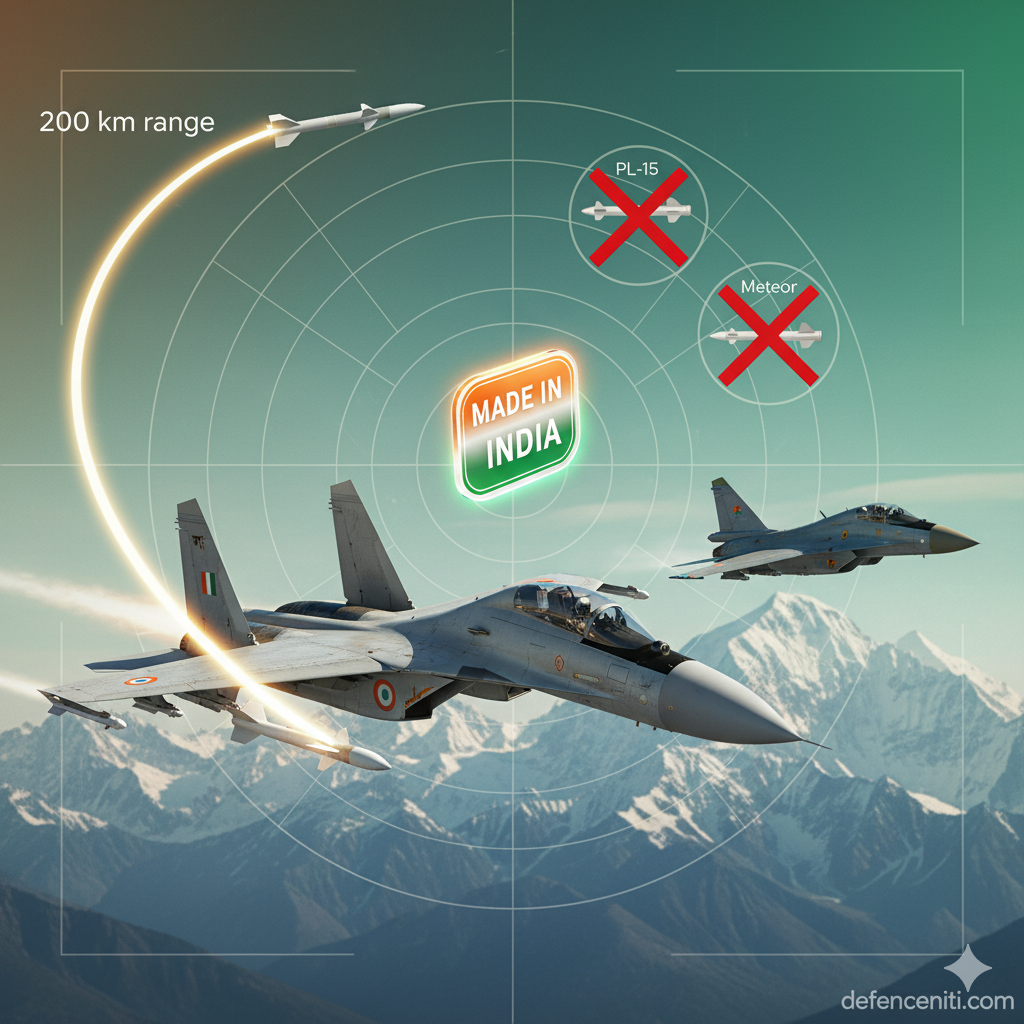Astra Mk-2 BVRL: IAF’s Standoff Leap with 700-Unit Order
In a bold stride towards aerial supremacy, the Defence Acquisition Council (DAC) greenlit the procurement of 700 Astra Mk-2 Beyond Visual Range (BVRL) air-to-air missiles on October 14, 2025, marking a transformative leap for the Indian Air Force (IAF). Developed indigenously by the Defence Research and Development Organisation (DRDO), this missile boasts a range exceeding 200 kilometers—doubling its predecessor’s reach—arming the IAF’s Su-30 MKI, Tejas Mk-1A, and future platforms like the Advanced Medium Combat Aircraft (AMCA). Valued at approximately ₹25,000 crore, this order not only fortifies combat readiness along the Line of Actual Control (LAC) but also reduces dependence on foreign systems like the Meteor missile. How will the Astra Mk-2 reshape air warfare, and what challenges await its deployment?
Technological Edge: Astra Mk-2 Unveiled
The Astra Mk-2 evolves from the Astra Mk-1, operational since 2020 with a 110 km range, into a cutting-edge weapon. Successfully tested in July 2025 at Chandipur’s Integrated Test Range, Odisha, it features an active radar seeker, robust electronic counter-countermeasures (ECCM), and a dual-pulse rocket motor for enhanced range and agility. With indigenous avionics and a smokeless propellant, it achieves Mach 4.5, outstripping many global rivals.
Key specifications:
- Range: 200-250 km (varies with altitude and launch conditions).
- Guidance: Active radar homing with mid-course datalink updates.
- Warhead: 60 kg high-explosive fragmentation with proximity fuse.
- Platforms: Su-30 MKI (initial), Tejas Mk-1A, and AMCA (future).
Its combat debut came during Operation Sindoor (August 2025), where it downed simulated Pakistani F-16s at 180 km in a Rajasthan exercise. DRDO chief Samir V. Kamat dubbed it a “force multiplier,” with production kicking off at Bharat Dynamics Limited (BDL) by mid-2026.
Strategic Shift: Beyond the Dogfight
The 700-missile order, part of a ₹2.23 lakh crore DAC package, tackles the IAF’s squadron shortfall (31 active vs. 42 needed) amid LAC tensions. Astra Mk-2’s beyond-visual-range (BVR) prowess shifts combat from dogfights to long-range strikes, countering China’s PL-15 (200 km) and Pakistan’s AIM-120C (100 km). It integrates with Su-30 MKI’s Phazotron Zhuk radar and Tejas’ EL/M-2052, boosting multi-role versatility.
This move cuts reliance on costly Meteor missiles (€2-3 million each), saving ₹15,000 crore over 10 years, per MoD projections. Operation Sindoor showcased its theater command potential, linking Astra with Akash ground defenses for layered protection.
Compare the specs:
| Missile | Range (km) | Speed (Mach) | Guidance | Indigenization | Cost (₹ Cr per Unit) |
|---|---|---|---|---|---|
| Astra Mk-2 | 200-250 | 4.5 | Active Radar | 85% | ~3.5 |
| Astra Mk-1 | 110 | 4.0 | RF Seeker | 80% | ~2.5 |
| Meteor (France) | 150-200 | 4.0 | RF/AESA | 0% | ~20 |
| PL-15 (China) | 200 | 4.0 | Active Radar | N/A | ~15 (est.) |
| Source: DRDO/IAF 2025 | |||||



